St. Januarius Church in Naples, NY
A history of and visit to St. Januarius Church in the Finger Lakes village of Naples near Canandaigua Lake.
by Chris Clemens
In 1779, German settlers came to the Finger Lakes area bringing with them the expertise of grape growing and winemaking.
They formed a small town known as “Watkinstown” named after a Revolutionary War Captain. Watkinstown was renamed to “Middletown” because of its position between Canandaigua and Bath. Then in 1808 it would be redesignated to the name we’re familiar with today: Naples. Many felt the landscape with rolling hills and rows of grapes had a familiar feel to the town in Italy.
With the new name, they tried to bring some of that old world familiarity to their new home.
As the town grew, 24 families came together and petitioned Bishop McQuaid of the Rochester Diocese to form a congregation. The group used the local town hall for a couple years while building on the corner of North Main and Tobey St. The church was traditional for the time, featuring a white-washed long and narrow, tall steeple with tall simple stained glass. In Upstate New York you’ve likely seen tons of churches that fit that kind of description. In the late 1960’s that church was torn down, and present day St. Januarius was built over a two year time span.
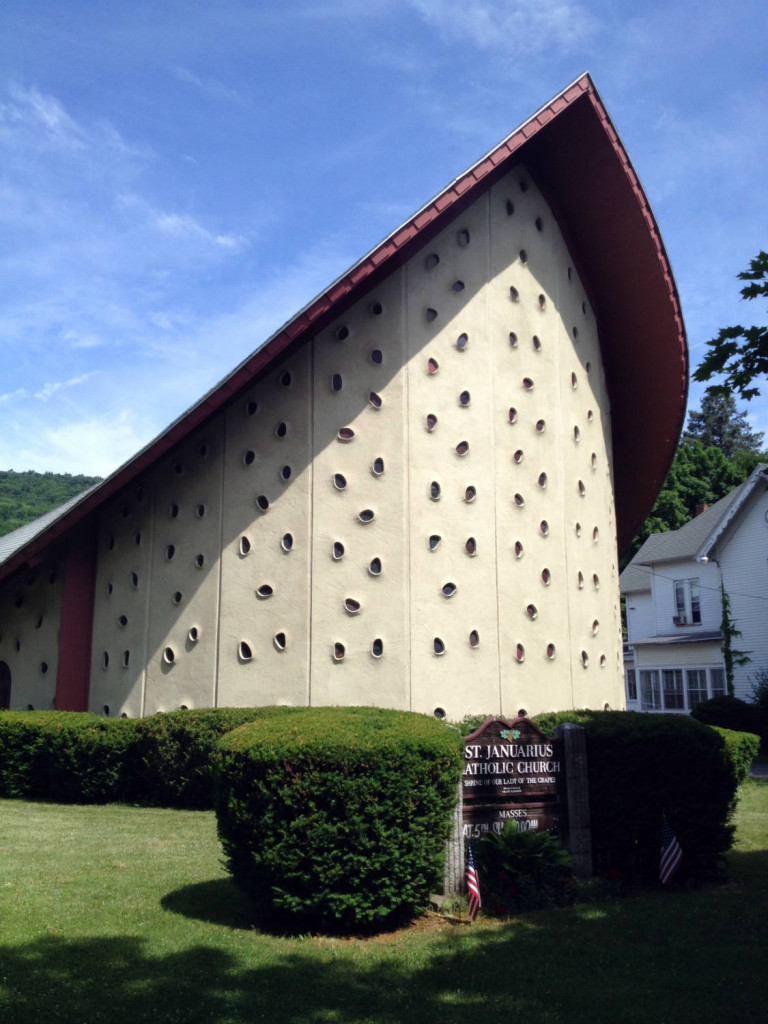
Januarius the Saint
St. Januarius church celebrates its namesake from a Bishop who served near Naples, Italy until he was martyred in 305 C.E. When Januarius was thrown to a fiery death and persecuted for his beliefs, it’s said that the flames never touched him. When that didn’t work, he was thrown to a pack of wild animals and still remained unscathed.
Finally, a beheading was ordered which did bring him to death. Afterward, a follower of Januarius collected a small vial of his blood. To this day, the vial bubbles and liquefies several times a year–especially near the Feast of St. Januarius on September 19th.
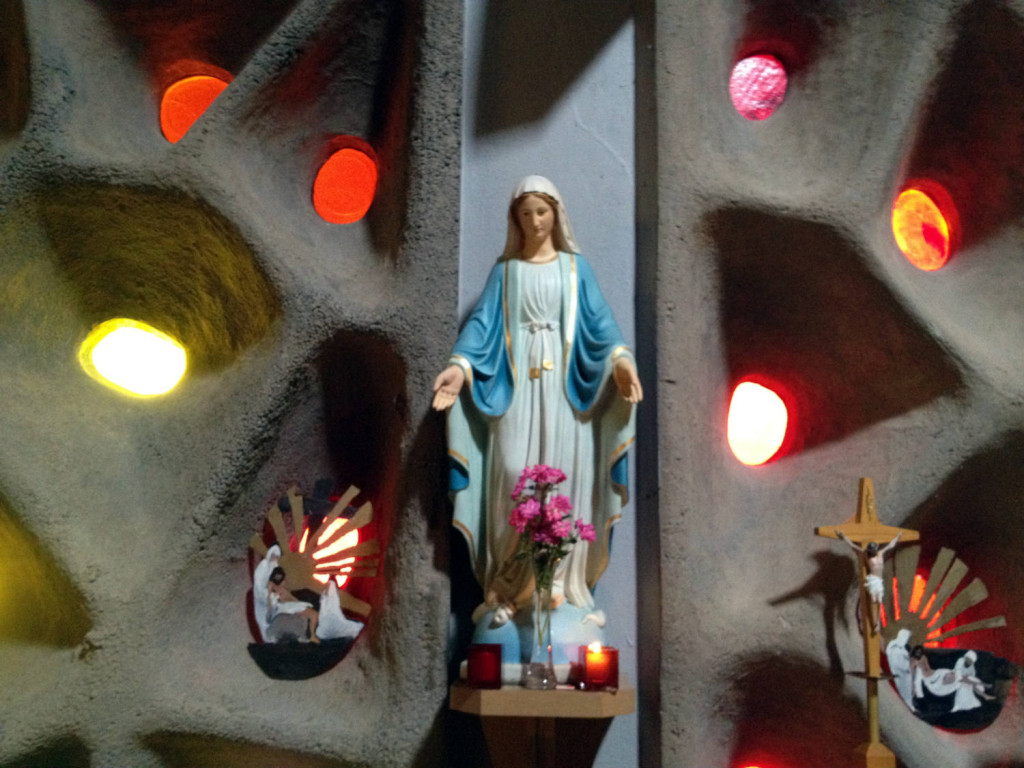
I should point out that many followers of the Catholic faith seem to disagree on the validity of the stories surrounding St. Januarius because so little is known or documented about his life. The more I dug for information, the different the stories get.
However, they all agree that the blood in the vials liquefies; though the Catholic church doesn’t recognize it as a miracle.
St. Januarius In The Finger Lakes
The present day St. Januarius was designed to incorporate and fit the local landscape while honoring the elements of the area. The town was named after Naples, Italy and the church was named after the patron saint of Naples, Italy. There’s no mistaking that a Italy theme was planned.
Architect Jim Johnson was commissioned to design a place for traditional Catholic worship with a bit a progressive inspiration. Johnson drew the out floor plan of the church to look like the outline of a grape leaf. The shape of the leaf is wide and tear-dropped coming to a point at the east side. Vertically, the shape continues with that theme by emulating the design of a grape leaf turned over, where the tip of the leaf actually points upward due to the strength of the midrib.
Instead of the long, narrow and tall steeple, St. Januarius embraced an idea that was catching on at the time. The concept was all about creating a wider, shorter church similar to that of a fan blade. The idea was that rather than sit in a pew facing perfectly forward only seeing the backs of the heads, you could now see the sides of the faces of the people you were in service with. It purposefully meant to instill a sense of community and belonging within the church.
Grape Architecture
Though the shape of the floor plan and the roof are unique, most people first notice the outside walls. The entire facade of the church wall is a plain and flat colored cement spotted with freckles of multi-colored glass. Continuing with a Naples theme, each of the stain glass dots represents the types of grapes grown locally.
While the outside is a smooth cement, the inside is entirely opposite. They constructed the wall panels with a process called sand-casting. By creating small cones of wet sand and pouring cement over the top, a deep concave window was created. Each of those peaks with a small colored window. Because the sand was reused and each panel had to be a different size, every panel ended up being an individual form. As a result, none of them are the same.
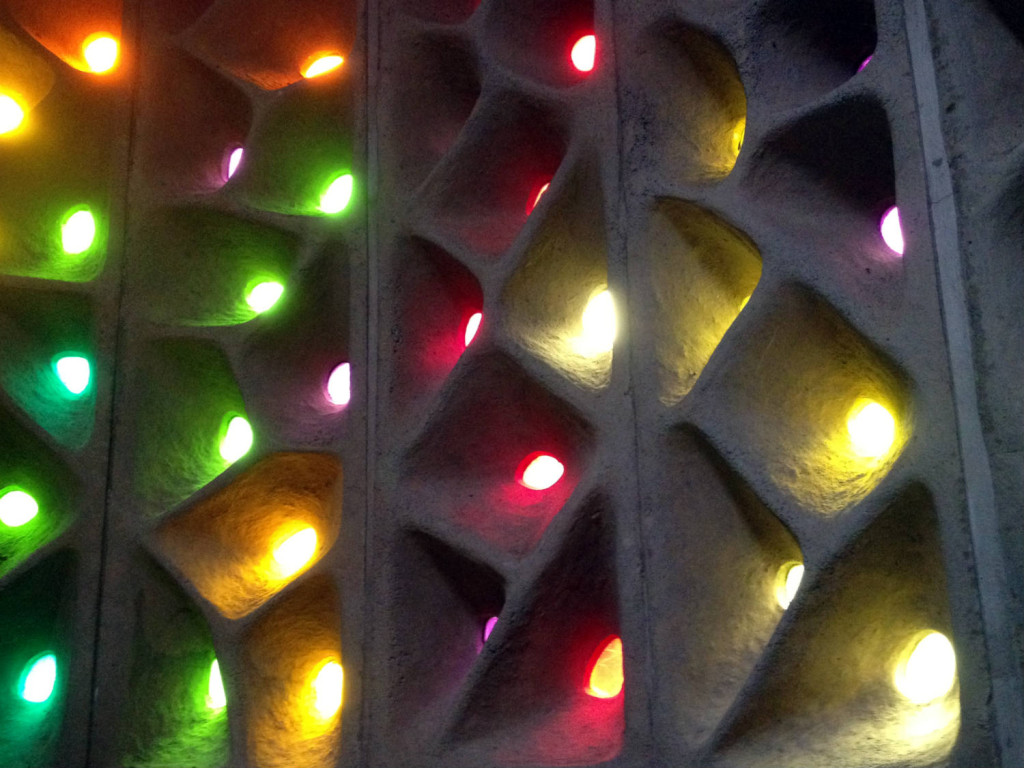
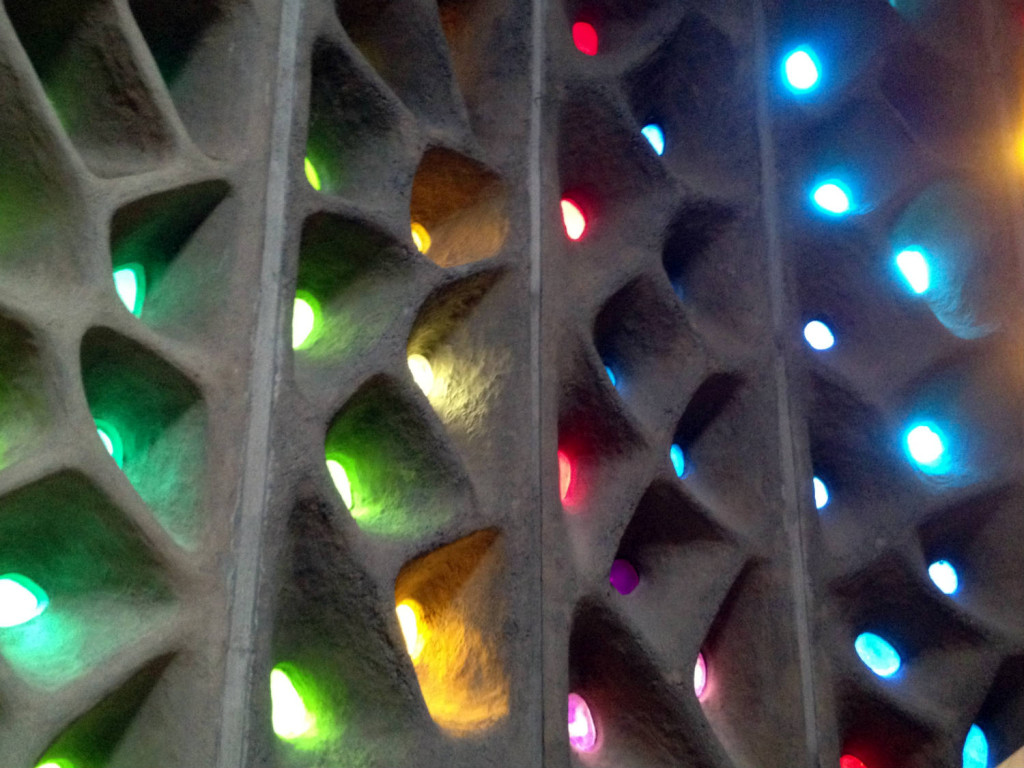
While visiting I watched a short video on the process and it looked horribly time consuming and tedious–the largest of the panels weighed in at 40 tons! It seems that the building of the church was more of a work of art rather than a construction job.
These windows are precisely why the newer church was built to face east. During the day, the lights shine inward and look incredible from the inside while at night, light shines out from within the church and the outside looks like Christmas tree lights.
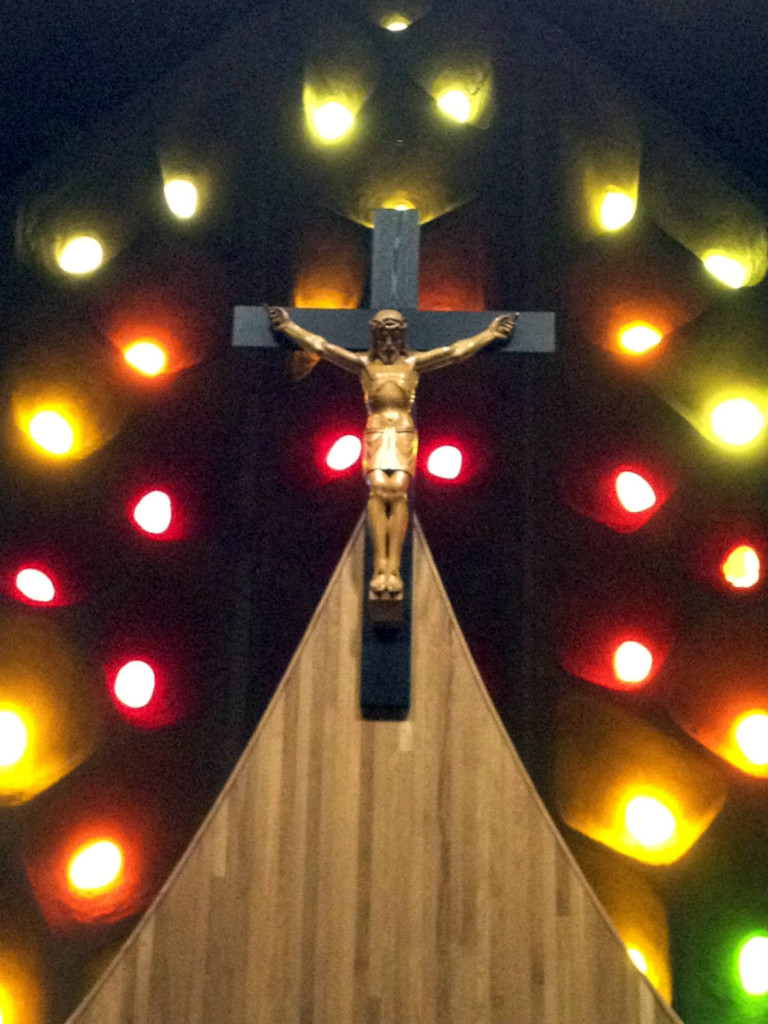
Supposedly, there was no rhyme or reason as to how the colors formed but it certainly seems that there was. Behind the raredos there is a collection of red windows forming almost the shape of a cross with orange and yellow surrounding it. Red = blood of Christ, orange and yellow = rising sun–it sure seems like there was at least some planning there.
Just A Few Changes
So, the old church had a long, narrow and tall nave with white-washed outsides and the new church had a wide, fanned shape nave with a wine cellar sort of feeling and specks of colored polka dots shining through.
The old church had an altar that stood traditionally atop five steps (the new church actually had this as well for a while) and faced away from the congregation while the new has only two steps, and a wheelchair ramp, and the altar sits away from the raredos so that the priest can face the congregation.
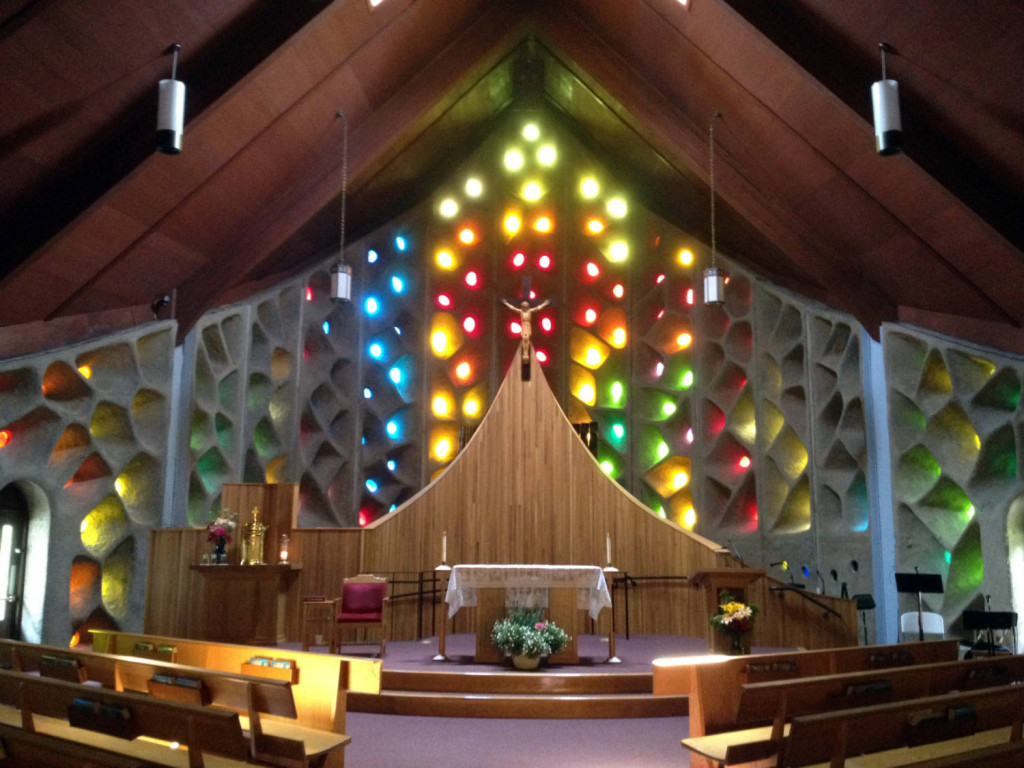
The worship space for this congregation took on an incredible transformation from traditional to artistic in a quick transformation. It’s pretty incredible if you take in to consideration Catholics’ willingness to go outside the box and try new things, and the fact that Naples, NY is fairly conservative in and of itself. To help the transition for some of the parishioners that weren’t as keen on the change, the new church continues to display the original stained glass windows from the old church. Though, they are on a wall and no natural light shines through them. They also have the original stoups from the old church, the original pews, and two lighting fixtures that hang above the altar.
Additionally, the front doors to the old church are now indoors and used as doors for the confessionals. In addition to the community center they added on to the back they continue to provide numerous renovations and additions as part of a two-phase project costing the congregation nearly $300,000. [June 26th, 2012 EDIT: It’s been brought to my attention by the Diocese of Rochester that the renovation costs were not incurred by the congregation. Rather, it was funded by two private donors, in addition to any parishioner who volunteered to donate toward the project.]
Go Visit
When we started our list of Sacred Sites in Upstate NY to visit, St. Januarius was included early on. The history of St. Januarius is rich and long, particularly for that area considering the amount of developed land in the Finger Lakes during that time span. But for me, the unique construction and look of the the church is what has always stood out.
If you’re in Naples, you should definitely see this in person!

*This post previously appeared on ExploringTheBurnedOverDistrict.com

Chris Clemens is the Founder/Publisher of Exploring Upstate. From his hometown in Rochester, he spends as much time as possible connecting with the history, culture, and places that make Upstate New York a land of discovery. Follow him on Twitter at @cpclemens

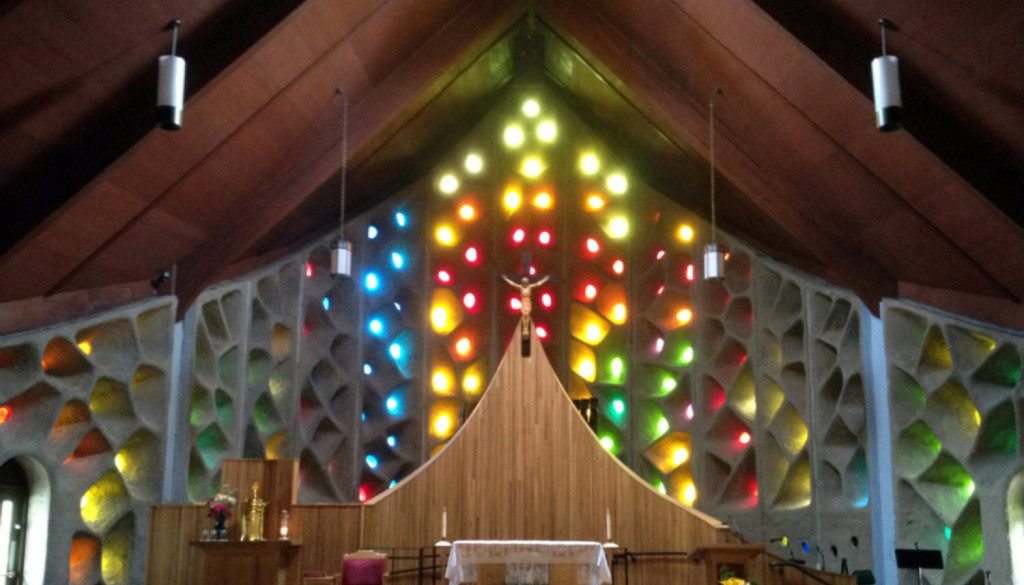
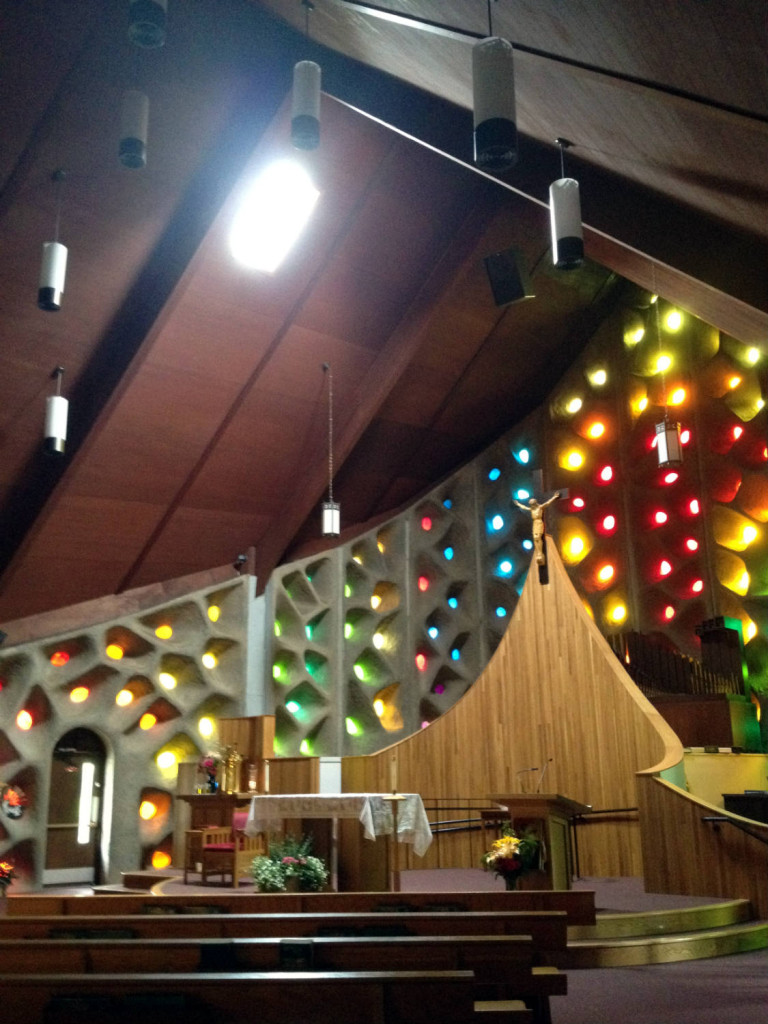


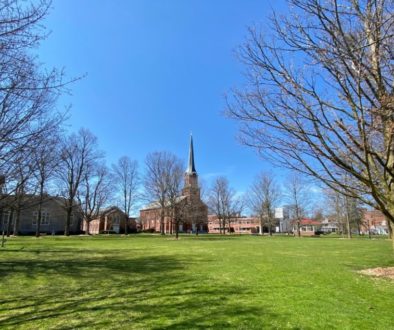
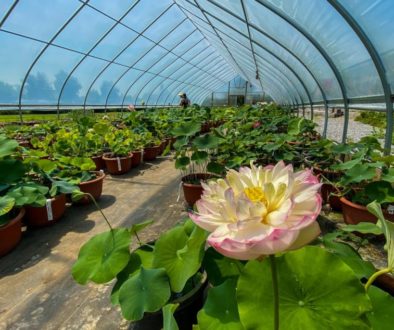
June 25, 2012 @ 3:53 pm
Thanks for sharing the challenging idea for our architecture here – a possible method? Fr. Julio.
June 26, 2012 @ 10:13 am
Great point Father! I didn’t think about the layout of the Fatima shrine being designed for the function of inspiring fellowship–just that it was to follow the form of the shape of the Earth.
As far as being a possible method, you all at the shrine are more of an expert than I’ll ever be able to be! I’m thinking a road trip will be in order soon to visit you guys and the shrine again–see you all soon!
June 25, 2012 @ 4:35 pm
I loved seeing the inside of this church when we visited several years ago and am so glad you finally got to see it too. Its just so different and pretty inside. So unusual. I bet its pretty at night from the outside as well. Thanks for putting this on for everyone to read about.
June 26, 2012 @ 10:20 am
Thanks for recommending that I go check it out–this was a good addition to our ever-expanding list!
June 26, 2012 @ 9:00 am
When I was a little girl I would worship at St. Januarius with my friend and her family. I was always more facinated with the rituals and the beauty of her church than I was my own. Great story – thanks for sharing!
June 26, 2012 @ 10:19 am
You got it! Thanks for checking out the blog. I’m not much of a chef, but I may grab one of the fantastic looking recipes off your blog and get someone I know to make it for me!!
February 13, 2013 @ 1:22 am
This is quite a delayed comment…but as a deeply devoted fan of James H Johnson’s work, I though I would bring to your attention the number of other extremely inspiring sanctuary spaces he has created.
St. John the Evangelist – Greece, NY
St. John the Baptist – Lockport, NY
St. Christopher’s – Chili, NY
AME Zion Chuch – Rochester, NY
Temple Sinai – Brighton, NY
Temple Beth Am – Henrietta, NY
Unfortunately Our Lady of Mercy Parish and Rectory, along with Penfield Presbyterian Church, have been lost to unsightly remodeling, or in the case of Our Lady of Mercy’s rectory, recently demolished this past year. Also, Jim is still very much alive and well, so feel free to give him a call, or as I am currently pursuing the writing of a monograph on his work, feel free to ask me any questions.
February 13, 2013 @ 9:28 am
Christopher,
Not delayed at all–it’s right on time! We have checked so much off our list of places to see that we are need of some new ones to research. Thanks for the tips on this, and we didn’t realize Mr Johnson was still alive. We’ll look more in to these. If you’re visiting Rochester while making efforts to complete your project, be in touch!
November 2, 2014 @ 8:11 am
Jim still alive ?? Please I need his biography may you help me? (I am an architecture student and im working on one of his houses realized) :s
The Publick Universal Friend – Penn Yan, NY » Chris & Luke Explore the Burned Over District
July 20, 2013 @ 11:31 am
[…] myself and my wife went and visited St. Januarius Church in Naples, NY (which you can read about here). On our way home from Naples, I came up with the bright idea to drive home through Penn Yan to […]
March 19, 2014 @ 12:10 am
I have driven past this Church many times and was always fascinated and intrigued by it’s outward appearance. While I am in no way a fan of modern Catholic architecture….. I have to admit, I love what I am seeing in these pictures! I was drawn to this building from the outside and can’t wait to visit again for morning Mass!
Thanks guys…. your work is inspiring.
Mike
Franciscan Church of the Assumption Parish
Syracuse, NY
April 26, 2019 @ 6:21 am
Excellent work, Chris. You have made yourself a good gig, and it just keeps getting better. I love your icon – the route sign.
You have misspelled vial once as ‘vile.’ Not want you want, I am sure. I’ve never seen a misspelling in your words. Plenty of them sneak by somehow in mine.
April 26, 2019 @ 7:15 am
Thanks, Tom! Glad you’re enjoying!
Great catch on the error–I’ve fixed it future readers.